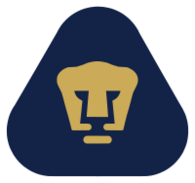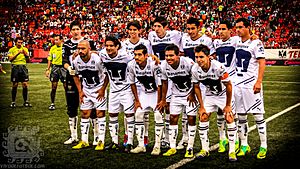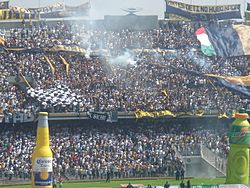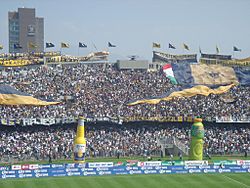Club Universidad Nacional facts for kids
 |
||||
| Full name | Club Universidad Nacional, A.C. | |||
|---|---|---|---|---|
| Nickname(s) | Pumas Universitarios (Collegiates) Universidad (University) Auriazules (Gold-and-Blues) El equipo del Pedregal (The Pedregal Team) |
|||
| Short name | UNAM, PUM | |||
| Founded | August 2, 1954, as Club Deportivo Universidad | |||
| Ground | Estadio Olímpico Universitario | |||
| Capacity | 58,445 | |||
| Owner | UNAM | |||
| Chairman | Luis Raúl González Pérez | |||
| Head coach | Efraín Juárez | |||
| League | Liga MX | |||
| Clausura 2025 | Regular phase: 10th Final phase: Play-in round |
|||
|
||||
Club Universidad Nacional, A.C., often called Pumas UNAM, is a professional football team from Mexico City. They play in Liga MX, which is the top football league in Mexico. The club started in 1954 as Club Deportivo Universidad. Their home games are played at Estadio Olímpico Universitario, a large stadium that can hold over 72,000 fans.
The club began as a team for students from the National Autonomous University of Mexico (UNAM). Over time, it grew into a professional team. Pumas UNAM is one of the most popular football clubs in Mexico. It's part of the Cuatro Grandes (Big Four) of Mexican football, along with Cruz Azul, Guadalajara, and Club América.
Pumas UNAM has won many awards in Mexico, including 7 Liga MX titles, 1 Copa MX, and the Campeón de Campeones twice. They also won 1 Segunda División de México title. In international games, they have won 3 CONCACAF Champions Cups and 1 Copa Interamericana. The team has a big rivalry with Club América, known as the derbi capitalino.
Their famous chant is, “Goya! Goya! Cachun, Cachun, Rah! Rah!” Pumas UNAM is also known for its great system that helps young players become professional stars. Many famous international players started their careers here, like Hugo Sánchez, Manuel Negrete, Luis Flores, and Jorge Campos.
Contents
Club History
The idea to have a football team from UNAM join Mexico's top league started early. In the 1940s, Gustavo Baz Prada, the university's dean, asked Rodolfo "Butch" Muñoz to create a team. Muñoz, a player from Club España, formed the team with university students. They did very well in university tournaments for 13 years, which helped them prepare to become a professional team later on.
Starting the Team: The 1950s
In August 1954, Club Universidad was allowed to join the Segunda División. This was the second-highest professional football league in Mexico at the time. This happened thanks to the support of Dean Nabor Carrillo and Guillermo Aguilar Alvarez Sr., who helped the club a lot. Aguilar Alvarez became the club's chairman.
On September 12, 1954, UNAM played its first professional game against Monterrey. After three years, the club took a break to rebuild its team. During this time, Hector Ortiz became the new manager, and a special group of supporters was formed.
Moving Up: The 1960s
Pumas UNAM finally moved up from the Segunda División to the Primera División (the top league) on January 9, 1962. They won their promotion match at home, beating Club Cataluña de Torreón 9–1. After the game, excited students rushed onto the field to celebrate with their team. This was a big step for the club.
The next day, Dean Ignacio Chávez Sánchez congratulated the team and their manager, Octavio Vial. The team quickly settled into the Primera División. The club's supporters also started a youth system to find and train new players for the future.
Becoming a Legend: The 1970s
After a few years, Ángel Zubieta became the team's manager. He brought in important international players but also focused on promoting young talent from the club's own youth system.
In the first half of the 1970s, three key foreign players joined the club: Juan José Muñante from Peru, Velibor "Bora" Milutinović from Serbia, and Cabinho from Brazil. They played alongside strong Mexican players like Miguel Mejía Barón and Leonardo Cuellar. These players helped the club win its first major titles.
In 1975, the club changed its management to an independent group that helped support the team. In the 1974–75 season, Universidad won the Copa México and the Campeón de Campeones. Then, in the 1976–77 season, Club Universidad won its first-ever league championship! This success continued with two second-place finishes. The decade ended with the exciting debut of Hugo Sánchez, who would become a football legend. In 1978, the club also signed Ricardo "Tuca" Ferretti, another player who would be very important for the team.
Stronger Than Ever: The 1980s
In the 1980–81 season, Universidad won its second league championship. This was also the last season Hugo Sánchez played for the club before moving to Europe. In the next season, the Pumas won the CONCACAF Championship and the Interamerican Cup.
During this decade, the club became famous across Mexico for its exciting and new style of play, which helped Mexican football grow. For the 1986 FIFA World Cup, the manager of Universidad, Velibor "Bora" Milutinović, was chosen to lead the Mexico national football team. He picked many Pumas players for the national team, including Hugo Sánchez and Manuel Negrete. These players brought a lot of joy to both Pumas fans and Mexican football fans.
Ups and Downs: The 1990s
The 1990s started with one of the most famous championships in the club's history. In the 1990–91 League Championship, Pumas played against their big rivals, Club América. The winning goal was a memorable free kick from Ricardo "Tuca" Ferretti. This was Ferretti's last game as a professional player. New talented players like Luis García and Jorge Campos joined the team. However, this decade is seen as one of the less successful times for the club in terms of winning championships and developing new players. Towards the end of the 1990s, Hugo Sánchez returned to manage the club for the first time.
Great Success: The 2000s
In 2004, Hugo Sánchez led the Pumas to their first championship in thirteen years. They did even better later that year by winning the championship again! This made them the first team to win back-to-back championships since the Mexican league changed its format. As of 2012, they were still the only team to have done this. Along with these two league titles, Pumas also won both the Campeon de Campeones trophies.
In 2005, the Pumas reached the Copa Sudamericana final, but they lost to Boca Juniors in a penalty shootout. After their big success in 2004, the Pumas faced some tough times and were even at risk of being moved to a lower league in 2006. Ricardo Ferretti was hired as manager again to help the team. His leadership brought stability, and Pumas moved out of the relegation zone. They even reached a final in 2007 against Atlante, but lost. In 2009, Ferretti led the Pumas to another final, where they beat Pachuca in extra time to win their sixth championship.
Rebuilding the Club: The 2010s

In 2011, Pumas became champions of the Clausura 2011 tournament, winning their seventh championship against Monarcas Morelia.
After some difficult years, Guillermo Vasquez returned as head coach in 2014. In the Apertura 2015 tournament, Pumas made it to the final against Tigres U.A.N.L.. Tigres won the first game 3–0. In the second game, Pumas fought back and tied the overall score 4–1 at home. The championship was decided by a penalty shootout, which Tigres won 4–2. So, Pumas couldn't get their eighth title. After failing to reach the playoffs in Clausura 2016 and the semifinals of the Copa Libertadores 2016, Guillermo Vasquez was replaced in May 2016.
At the end of May 2016, Francisco Palencia became the new head coach. In the Apertura 2016 playoffs, Pumas played Tigres again in the quarter-finals. The first game was a 2-2 tie. In the second game, Tigres won 5–0, meaning Pumas lost 7–2 overall and were out of the playoffs.
In Clausura 2017, Pumas signed Chilean forward Nicolas Castillo to boost their attack. He scored 8 goals in the first two months but then got injured and missed the rest of the season. Pumas had a good start but then lost four straight games and finished 17th.
In Apertura 2017, many key players, like Alejandro Palacios and long-time captain Dario Veron, were sold or loaned out. This was done to make room for new, young players.
The 2020s and Beyond
In the 2020 Apertura, Pumas reached the final but lost to Club Leon with a 3-1 total score. This was under coach Andres Lillini, who took over after Michel left. In 2022, Pumas made it to the Champions League Final, where they lost to the Major League Soccer team Seattle Sounders FC.
After a tough 2023 Apertura, Lillini was replaced by Rafael Puente Jr.. Puente Jr. was then replaced by Antonio "Turco" Mohamed in March 2023 after a difficult start to the 2023 Clausura. Mohamed resigned shortly after Pumas was eliminated in the semifinals of the 2023 Apertura by Tigres. Gustavo Alberto Lema, Mohamed's assistant, took over until March 2025, when former UNAM player Efraín Juárez became the new head coach.
Home Stadium
The Pumas play their home games at the Estadio Olímpico Universitario. This stadium was the main place for the 1968 Summer Olympics. It can hold over 72,000 people. The stadium is located right on the university campus, making it easy for students to get there. Pumas also have training areas on campus, but their main training complex, called the Cantera, is nearby.
Team Rivalries
Universidad has strong rivalries with Club América and Cruz Azul. These games are very exciting and watched by many people across Mexico City. There's also a smaller, older rivalry with Leones Negros.
Clásico Capitalino: Pumas vs. América

The rivalry with Club América started in the 1960s when Universidad moved up to the top league. Both clubs are from Mexico City, which naturally creates a rivalry. The rivalry grew in the 1980s when Club América beat Universidad twice in league finals, with some controversial referee decisions. The 1990s started with a big win for Pumas over América in the league finals. Even though the total score was a tie, Pumas won because they scored more goals away from home. This rivalry is known for being very intense, and security is always very high for these games.
Pumas UNAM vs. Cruz Azul
The rivalry with Cruz Azul also comes from both clubs being in Mexico City. They have played many important matches, including two league finals. This game is sometimes called the "Clásico Metropolitano" or "Derby central" because both teams started in the central part of Mexico.
Clásico Universitario: Pumas vs. Leones Negros
Pumas UNAM and Leones Negros have an old rivalry. Both clubs were started by rival universities. A big moment in their rivalry was the 1976-77 Primera División final, where Pumas UNAM beat Leones Negros to win their first title. However, this rivalry has become less intense over the years because Leones Negros spent time in a lower league.
Fan Support
A survey from 2021 showed that Pumas UNAM has the 4th largest fan base in Mexico, with about 9.7% of fans, or 12 million supporters. Historically, it was the third most popular club in Mexico, behind Club América and CD Guadalajara. But since 2015, it has been fourth, behind Cruz Azul.
Supporter Groups
Pumas has two main supporter groups, known as barra bravas: La Rebel and La Plus.
Team Colors and Nickname
The team's blue and gold colors were chosen to honor the University of Notre Dame in the United States. Their football coaches helped develop an American-style football team at UNAM. The nickname "Pumas" was inspired by Roberto 'Tapatio' Mendez, who coached the team from 1946 to 1964. He often compared his players to pumas in his speeches, saying they were strong and agile. The nickname stuck, and now all sports teams representing the university are called Pumas.
Past Uniforms
- First kit evolution
|
1941
|
1943
|
1950
|
1953
|
1953
|
1960
|
1960
|
1975
|
1975-1976
|
1975-1976
|
Team Achievements
National Titles
| Type | Competition | Titles | Winning editions | Runners-up |
|---|---|---|---|---|
Top division |
Primera División/Liga MX | 7 | 1976–77, 1980–81, 1990–91, Clausura 2004, Apertura 2004, Clausura 2009, Clausura 2011 | 1966–68, 1977–78, 1978–79, 1984–85, 1987–88, Apertura 2007, Apertura 2015, Guardianes 2020 |
| Copa México | 1 | 1974–75 | – | |
| Campeón de Campeones | 2 | 1975, 2004 | 2005 | |
| Promotion division | Segunda División | 1 | 1961–62 | – |
| Copa de la Segunda División | 0 | – | 1960–61 | |
| Campeón de Campeones de la Segunda División | 0 | – | 1962 |
International Titles
| Type | Competition | Titles | Winning editions | Runners-up |
|---|---|---|---|---|
| Intercontinental CONCACAF CONMEBOL |
Copa Interamericana | 1 | 1981 | 1990 |
Continental CONCACAF |
CONCACAF Champions Cup/Champions League | 3 | 1980, 1982, 1989 | 2005, 2022 |
| Continental CONMEBOL | CONMEBOL Sudamericana | 0 | – | 2005 |
Friendly Tournament Wins
- Torneo Pentagonal Juan Fernández Albarrán: 1969
- Torneo Cuadrangular de Agosto: 1971
- Coors California Cup: 1985
- Copa Pachuca: 1994
- Copa Universidades de América: 2000
- Dallas Cup: 2001
- Trofeo Santiago Bernabéu: 2004
- Copa Chiapas: 2008
- Club International Tournament: 2012
- Trofeo Reto del Sol: 2012
- Cotton Bowl Tournament: 2012
- Copa Feria de León: 2017
Team Personnel
Current Coaches and Staff
- Last updated: May 4, 2024
Management Team
| Position | Staff |
|---|---|
| President | Luis Raúl González Pérez |
| Vice President of Sporting | Miguel Mejía Barón |
| Executive Vice President | Enrique Sánchez González |
| Director of Academy | Raúl Alpizar |
Players
Current Team Squad
|
|
Other Players Under Contract
|
Players on Loan to Other Teams
|
|
Reserve and Youth Academy Teams
Pumas Players in the World Cup
The following players represented their country at the World Cup while playing for Pumas UNAM:
 Aarón Padilla (1966, 1970)
Aarón Padilla (1966, 1970) Luis Regueiro (1966)
Luis Regueiro (1966) Elías Muñoz (1966)
Elías Muñoz (1966) Enrique Borja (1966, 1970)
Enrique Borja (1966, 1970) José Luis González (1970)
José Luis González (1970) Mario Velarde (1970)
Mario Velarde (1970) Francisco Castrejón (1970)
Francisco Castrejón (1970) Arturo Vázquez Ayala (1978)
Arturo Vázquez Ayala (1978) Enrique López Zarza (1978)
Enrique López Zarza (1978) Hugo Sánchez (1978)
Hugo Sánchez (1978) Leonardo Cuéllar (1978)
Leonardo Cuéllar (1978) Juan José Muñante (1978)
Juan José Muñante (1978) Miguel España (1986)
Miguel España (1986) Félix Cruz (1986)
Félix Cruz (1986) Luis Flores (1986)
Luis Flores (1986) Raúl Servín (1986)
Raúl Servín (1986) Rafael Amador (1986)
Rafael Amador (1986) Manuel Negrete (1986)
Manuel Negrete (1986) Jorge Campos (1994, 1998, 2002)
Jorge Campos (1994, 1998, 2002) Claudio Suárez (1994, 1998, 2006)
Claudio Suárez (1994, 1998, 2006) Juan de Dios Ramírez Perales (1994)
Juan de Dios Ramírez Perales (1994) Braulio Luna (1998, 2002)
Braulio Luna (1998, 2002) Pablo Barrera (2010)
Pablo Barrera (2010) Israel Castro (2010)
Israel Castro (2010) Efraín Juárez (2010)
Efraín Juárez (2010) Darío Verón (2010)
Darío Verón (2010) Jesús Gallardo (2018)
Jesús Gallardo (2018) Dani Alves (2022)
Dani Alves (2022)
Team Managers
 Rodolfo "Butch" Muñoz (Sep. 1954–Mar. 1955)
Rodolfo "Butch" Muñoz (Sep. 1954–Mar. 1955) Donato Alonso (Apr. 1955–1956)
Donato Alonso (Apr. 1955–1956) Héctor Ortiz Benítez (1958-1960)
Héctor Ortiz Benítez (1958-1960) Octavio Vial (Sep. 1960–Aug. 62)
Octavio Vial (Sep. 1960–Aug. 62) Luis Carlos "Carlito" Peters (Aug. 1962) (interim)
Luis Carlos "Carlito" Peters (Aug. 1962) (interim) Renato Cesarini (Aug. 1962–Dec. 1965)
Renato Cesarini (Aug. 1962–Dec. 1965) Ángel Papadópulos Ruiz (Jan. 1965–1966)
Ángel Papadópulos Ruiz (Jan. 1965–1966) Diego Mercado Marín (1966–67)
Diego Mercado Marín (1966–67) Walter Ormeño (1967–68)
Walter Ormeño (1967–68) Árpád Fekete (1968–69)
Árpád Fekete (1968–69) Ángel Zubieta (1970–74)
Ángel Zubieta (1970–74) Luiz Carlos "Carlito" Peters (Jul.–Dec.1974)
Luiz Carlos "Carlito" Peters (Jul.–Dec.1974) Carlos Iturralde Rivero (Jan.–Apr. 1975)
Carlos Iturralde Rivero (Jan.–Apr. 1975) Árpád Fekete (Apr. 1975–76)
Árpád Fekete (Apr. 1975–76) Jorge Marik (1976–77)
Jorge Marik (1976–77) Velibor "Bora" Milutinović (1977–Dec. 1982)
Velibor "Bora" Milutinović (1977–Dec. 1982) Mario Velarde (Jan. 1983–Jun. 1987)
Mario Velarde (Jan. 1983–Jun. 1987) Héctor Sanabria (Jun. 1987–Jun. 1988)
Héctor Sanabria (Jun. 1987–Jun. 1988) Miguel Mejía Barón (Jul. 1988–91)
Miguel Mejía Barón (Jul. 1988–91) Ricardo Ferretti (1991–96)
Ricardo Ferretti (1991–96) Pablo Luna (Jun.–Sep. 1996)
Pablo Luna (Jun.–Sep. 1996) Luis Flores (Sep. 1996–97)
Luis Flores (Sep. 1996–97) Enrique López Zarza (1997–98)
Enrique López Zarza (1997–98) Roberto Saporiti (1998–99)
Roberto Saporiti (1998–99) Rafael Amador (1999–00)
Rafael Amador (1999–00) Hugo Sánchez (2000)
Hugo Sánchez (2000) Miguel Mejía Barón (2001)
Miguel Mejía Barón (2001) Hugo Sánchez (2001–05)
Hugo Sánchez (2001–05) Miguel España (2005–06)
Miguel España (2005–06) Guillermo Vázquez (2006)
Guillermo Vázquez (2006) Ricardo Ferretti (2006–10)
Ricardo Ferretti (2006–10) Guillermo Vázquez (2010–12)
Guillermo Vázquez (2010–12) Joaquín del Olmo (2012)
Joaquín del Olmo (2012) Juan Antonio Torres (2012)
Juan Antonio Torres (2012) Mario Carrillo (2012)
Mario Carrillo (2012) Juan Antonio Torres (2012–13)
Juan Antonio Torres (2012–13) José Luis Trejo (2013–14)
José Luis Trejo (2013–14) Guillermo Vázquez (2014–16)
Guillermo Vázquez (2014–16) Francisco Palencia (2016–17)
Francisco Palencia (2016–17) Sergio Egea (2017)
Sergio Egea (2017) David Patiño (2017–19)
David Patiño (2017–19) Bruno Marioni (2019)
Bruno Marioni (2019) Míchel (2019–20)
Míchel (2019–20) Andrés Lillini (2020–2022)
Andrés Lillini (2020–2022) Rafael Puente Jr. (2022–2023)
Rafael Puente Jr. (2022–2023) Antonio Mohamed (2023)
Antonio Mohamed (2023) Gustavo Lema (2024–2025)
Gustavo Lema (2024–2025) Efraín Juárez (2025–Present)
Efraín Juárez (2025–Present)
See also
 In Spanish: Club Universidad Nacional para niños
In Spanish: Club Universidad Nacional para niños


